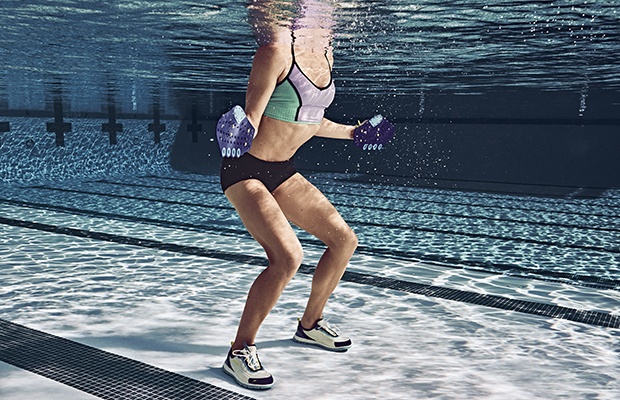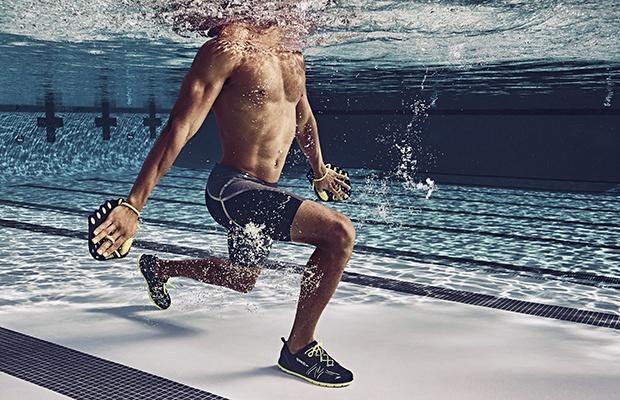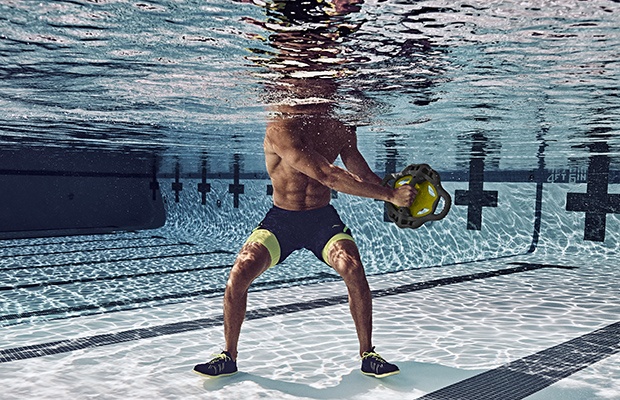This article originally appeared on Life by Daily Burn.
HIIT workouts have been a big hit among gym goers for years now. Understandably so: They crush loads of calories and improve your fitness, fast. But sometimes you need to switch up those all-out-effort intervals to give your body a break — and challenge it in new ways. Enter these pool exercises from Life Time Fitness, EXOS and Speedo’s collaborative class, WTRX.
An important note: This is not your grandma’s aqua aerobics class. You may not hold regular water classes to the same fitness standards as, say, a bootcamp. But that’s exactly why fit pros created WTRX.
“In a nutshell, I wanted to bring sexy back to the pool,” says Rob Glick, senior director of programming and innovation at Life Time Fitness. “When we think about HIIT classes, they’re pretty rugged, pretty intense and pretty sexy. A lot of times when people think about aqua classes, those are not the words people would use.” That is, until now.
RELATED: How to Swim Like an Olympian (Plus an All-Levels Workout)
Making Aqua Workouts Awesome
WTRX, offered at Life Time locations across the U.S., starts with a dynamic warm-up both in the water and on the deck. Then, like classes you might take in a studio, you’ll move around different stations, doing exercises that challenge your muscles and get your heart rate revved. Instructors also mix in high-energy activities, like partner races across the pool, treading water or a quick run of Marco Polo. (Work hard, play hard, as they say.)
Even if some of the exercises performed in WTRX look similar to those you’d do on land, the experience is totally different. And Glick explains several reasons for that.
RELATED: 6 Pool Workouts Worth Diving Into This Summer
First off, the water slows down your movements so you can better your coordination. For example, if you have trouble with a single leg squat or kettlebell swing outside of the pool, you’ll be able to work on your form and execution in the water, Glick explains.
Working out in the water also means less gravity, which leads to less impact on your joints. So you won’t wake up feeling super sore the next day. “Training in water removes the eccentric action of exercises,” says Glick. “That’s where most delayed onset muscle soreness comes from” — that downward phase of lifting.
Finally, it also adds constant resistance to every motion you make and in every direction. For instance, when you do a bicep curl, the downward motion works your triceps as you act against the H2O. Better yet, you’ll lap up the fun factor as you race around the pool.
RELATED: 3 Swimming Workouts for Every Skill Level
5 Pool Exercises to Dive Into
Now it’s time to dip your toes into WTRX with these five pool exercises, borrowed from the class. You can turn them into a HIIT workout by performing each exercise for 30 seconds each — and working at your max exertion level — with 15 seconds of rest in between each. Do as many rounds as possible. Your fresh (water) HIIT workout awaits!

Photo courtesy of Speedo
1. Fly
While the move in WTRX calls for Speedo Fit’s Clutch Paddles, you can also do this without equipment. Just keep your hands in blades, and move quickly but with control through the move. You’ll feel the resistance on both the forward and backward motion.
How to: Stand with your feet hip-width apart, slight bend in the knees. Start with your hands out in front of you, elbows bent about 90 degrees, palms facing each other (a). Squeeze your shoulder blades together as your move your hands back and in line with your torso. Elbows stay bent (b). Keeping the same bent-arm position, use your chest muscles to bring your hands back together in front of you (c). Repeat.
2. Kettlebell Swing
The water might make your weight feel lighter, but you still need solid form. You’ll also feel extra resistance as you drive through your hips and bring the kettlebell upward. Use a dumbbell here if you don’t have a kettlebell.
How to: Start with your feet a little wider than hip-distance apart, holding the kettlebell handle with both hands (a). Inhale and hinge at the hips, bringing the bell between your legs (b). Drive your hips forward as you swing the kettlebell up to about chest height. Exhale at the top and keep your abs engaged as you move (c). Let the weight fall back between your legs as you hinge forward again, then repeat.
RELATED: 7 Impressive Kettlebell Exercises for a Total-Body Workout

Photo courtesy of Speedo
3. Plyo Lunges
This might seem easier than it does on land, but that also means you need to have more control as you lower yourself toward the pool floor. Use dumbbells instead of kettlebells if necessary.
How to: Start standing with a kettlebell in each hand (a). Jump your feet to a staggered position and lower down so each of your knees bend to a 90-degree angle (b). Explode off your feet and switch your legs as you jump. Your opposite foot should land in front. Land softly and lower back down to a 90-degree bend in both knees (c). Jump back up and continue alternating.
RELATED: 5 Power Lunges for Killer Glutes
4. Muscle-Up
Like a push-up but performed from an upright angle, you’ll also get your obliques involved in this move.
How to: Standing in the pool, but close to the deck, place your hands about shoulder-width apart and rest them on the pool deck (a). Push into the deck to lift yourself up and out of the water, as you sit your right hip on the deck, to the outside of your right hand (b). Jump back down into the water, keeping your hands on the deck (c). Repeat on the left side and continue alternating.

Photo courtesy of Speedo
RELATED: Hate Crunches? 6 Better Core Exercises for Beginners
5. Trunk Rotation
In WTRX, you’ll use Speedo Fit’s Push Plate, but a dumbbell also works if you’re trying to limit the equipment. You’ll feel the resistance from all angles, working your core in every direction.
How to: Start standing with your feet hip-width apart, holding a weight with both hands (a). Lower down into a shallow squat and bring the weight straight out in front of you (b). Rotate your torso to the left as you keep your arms straight and move the weight to your left, too (c). Twist your torso all the way to the right, so the weight comes to the right side of your body (d). Continue alternating sides.